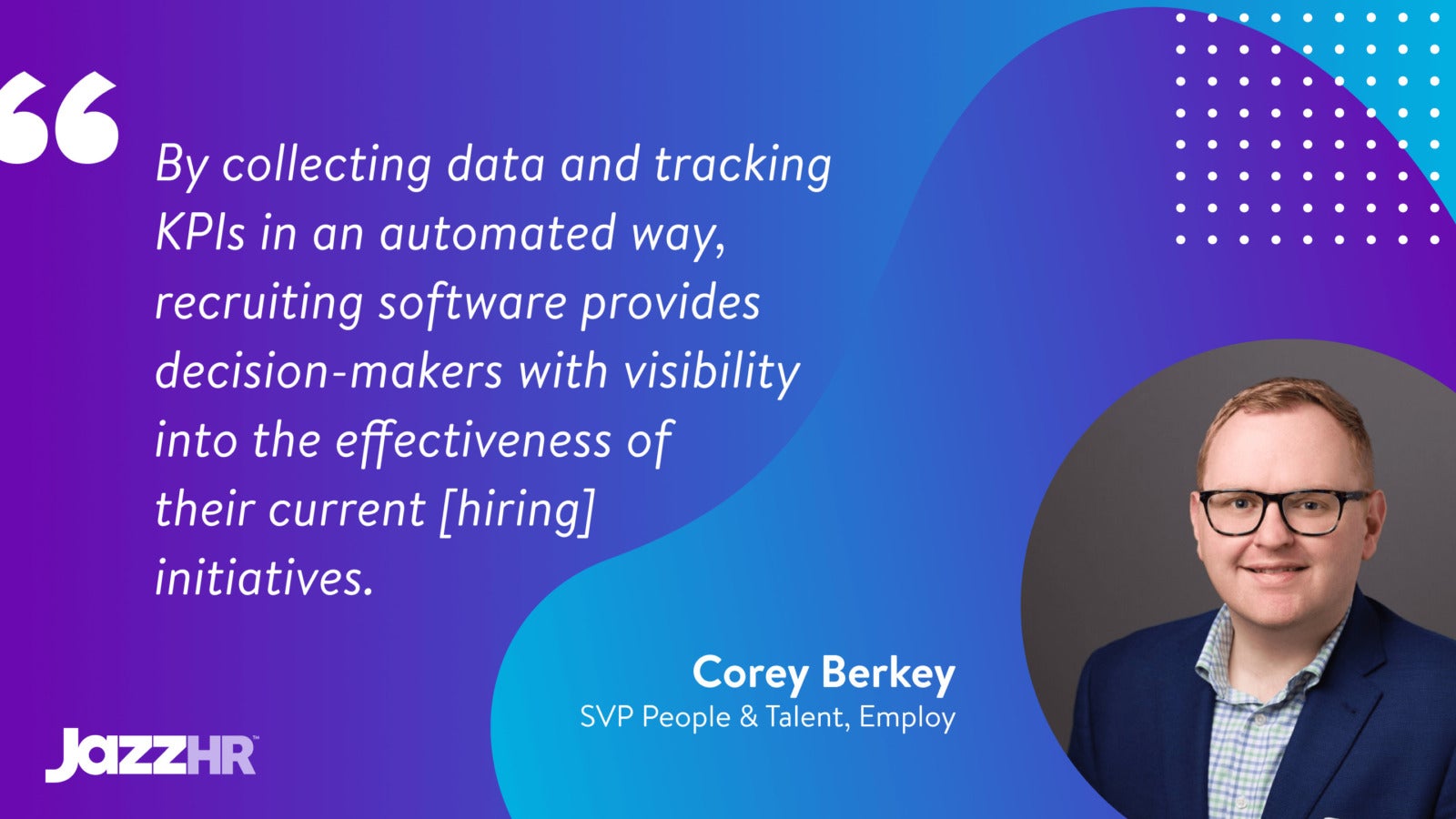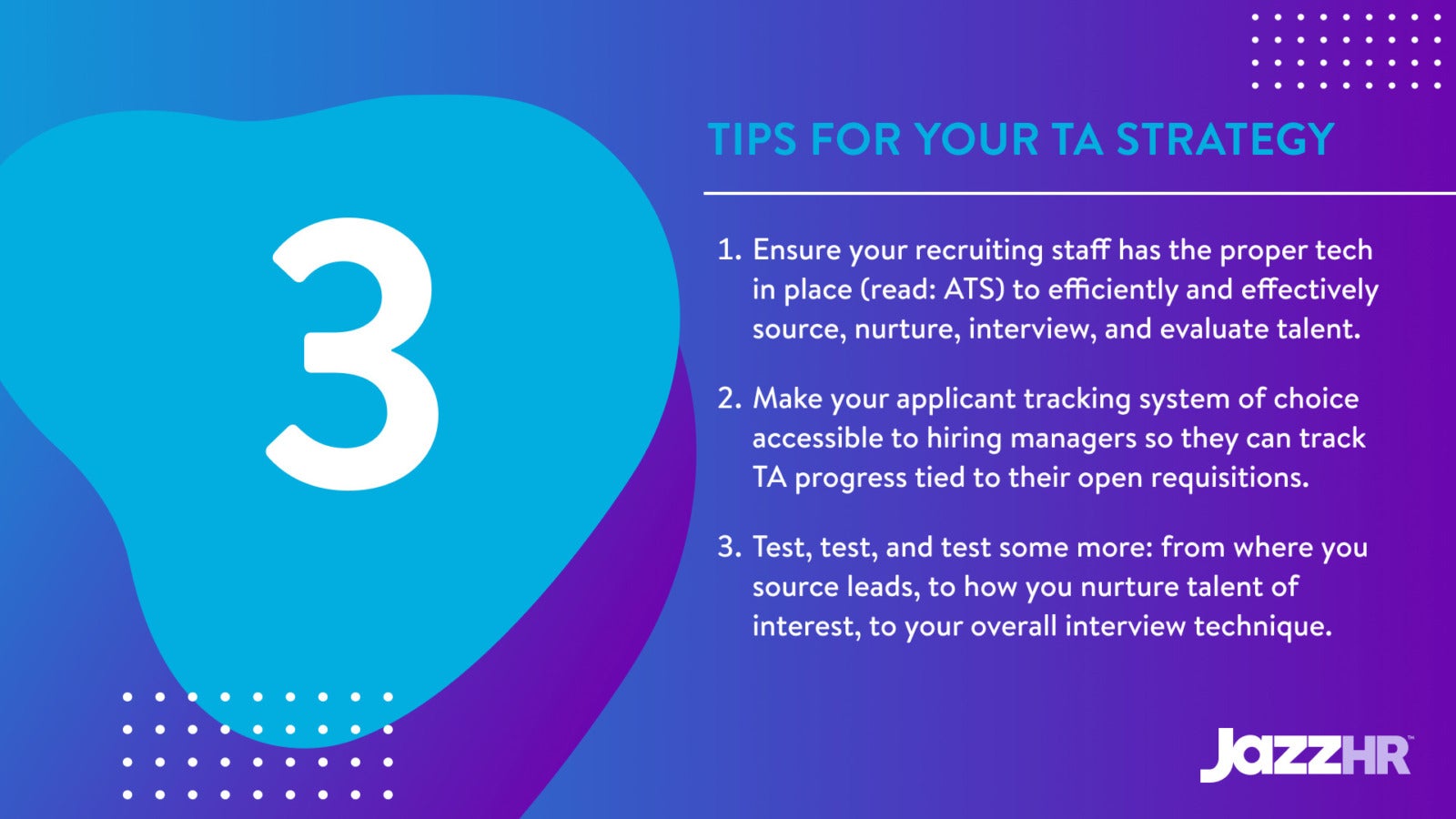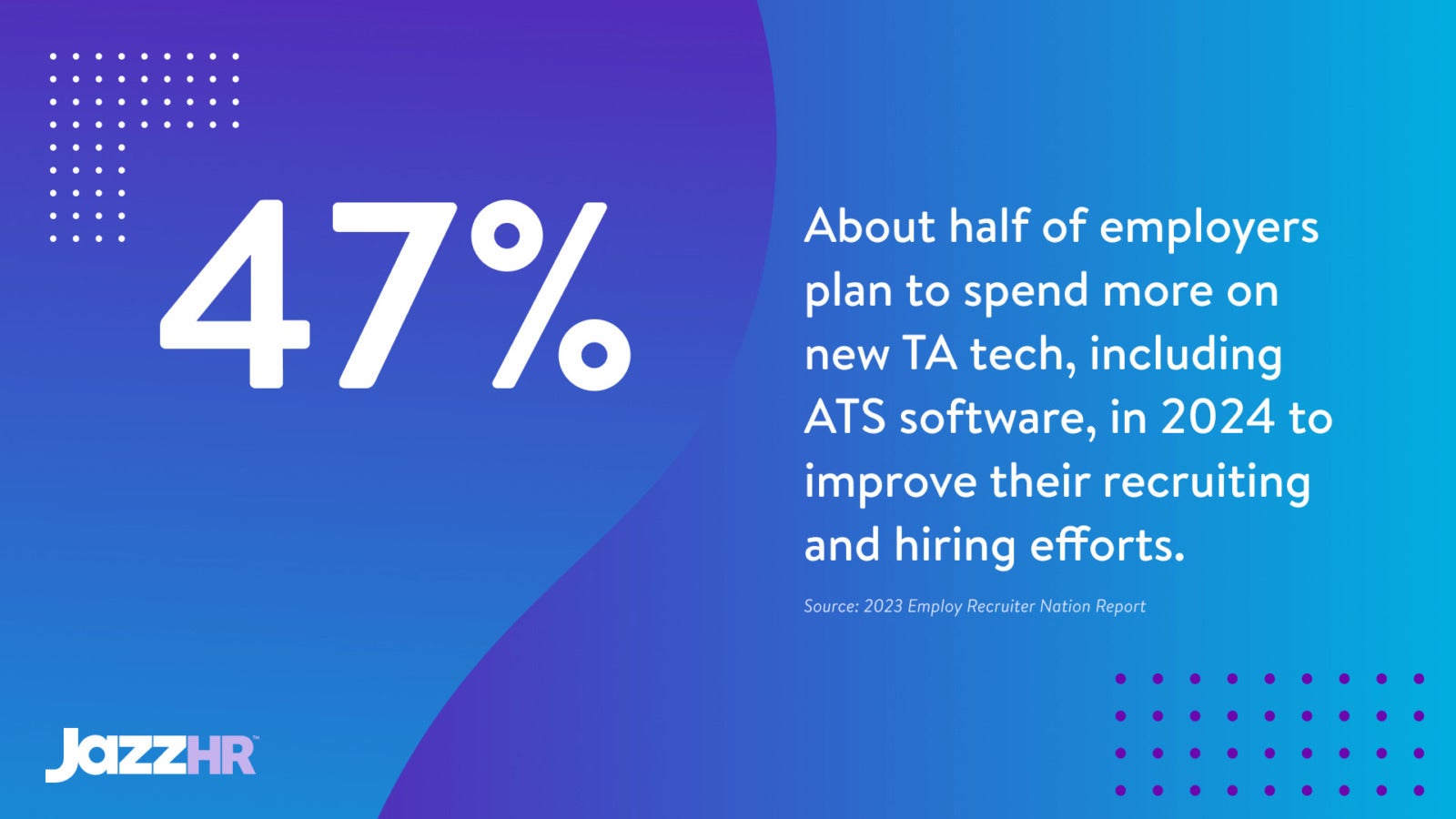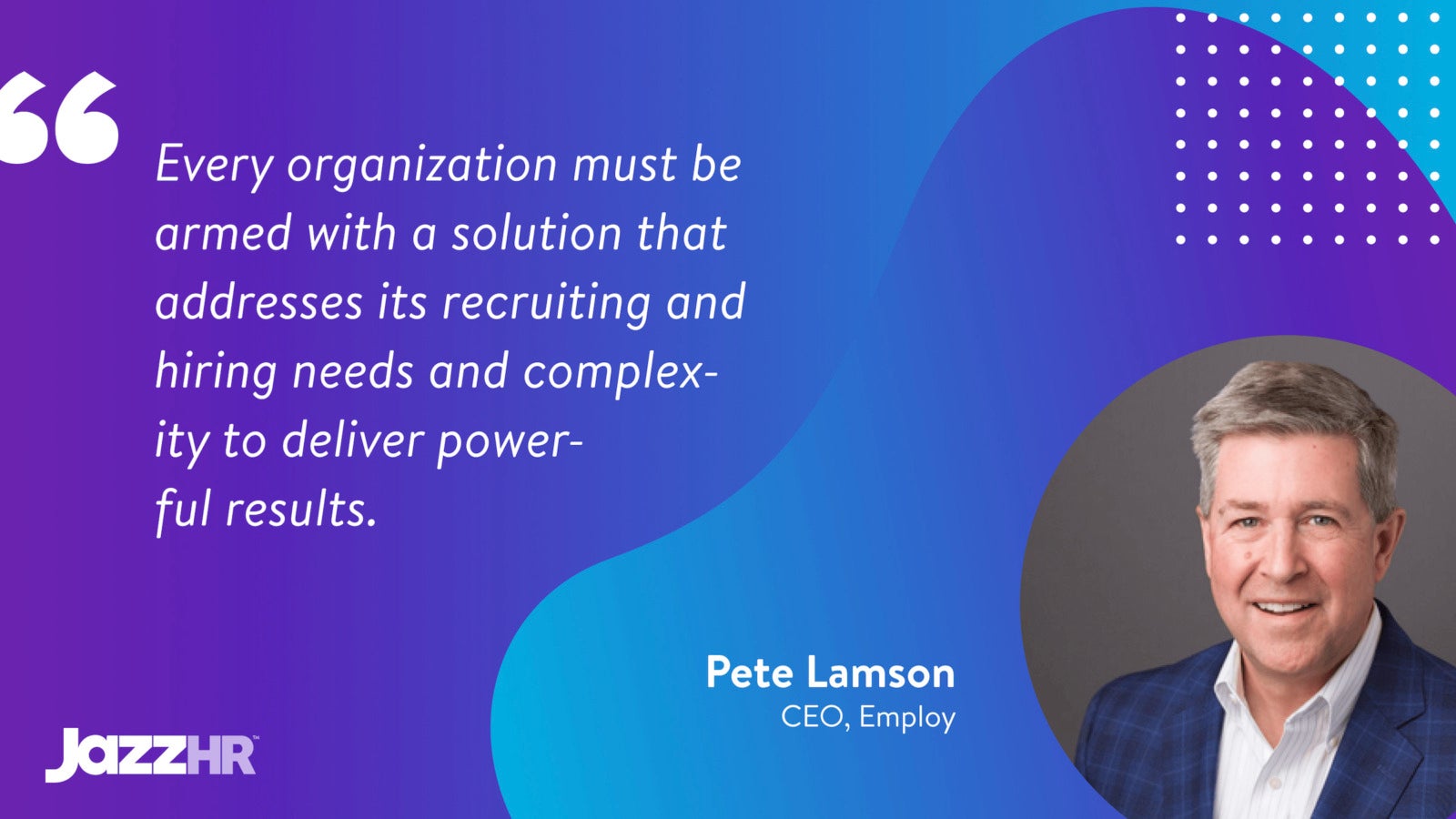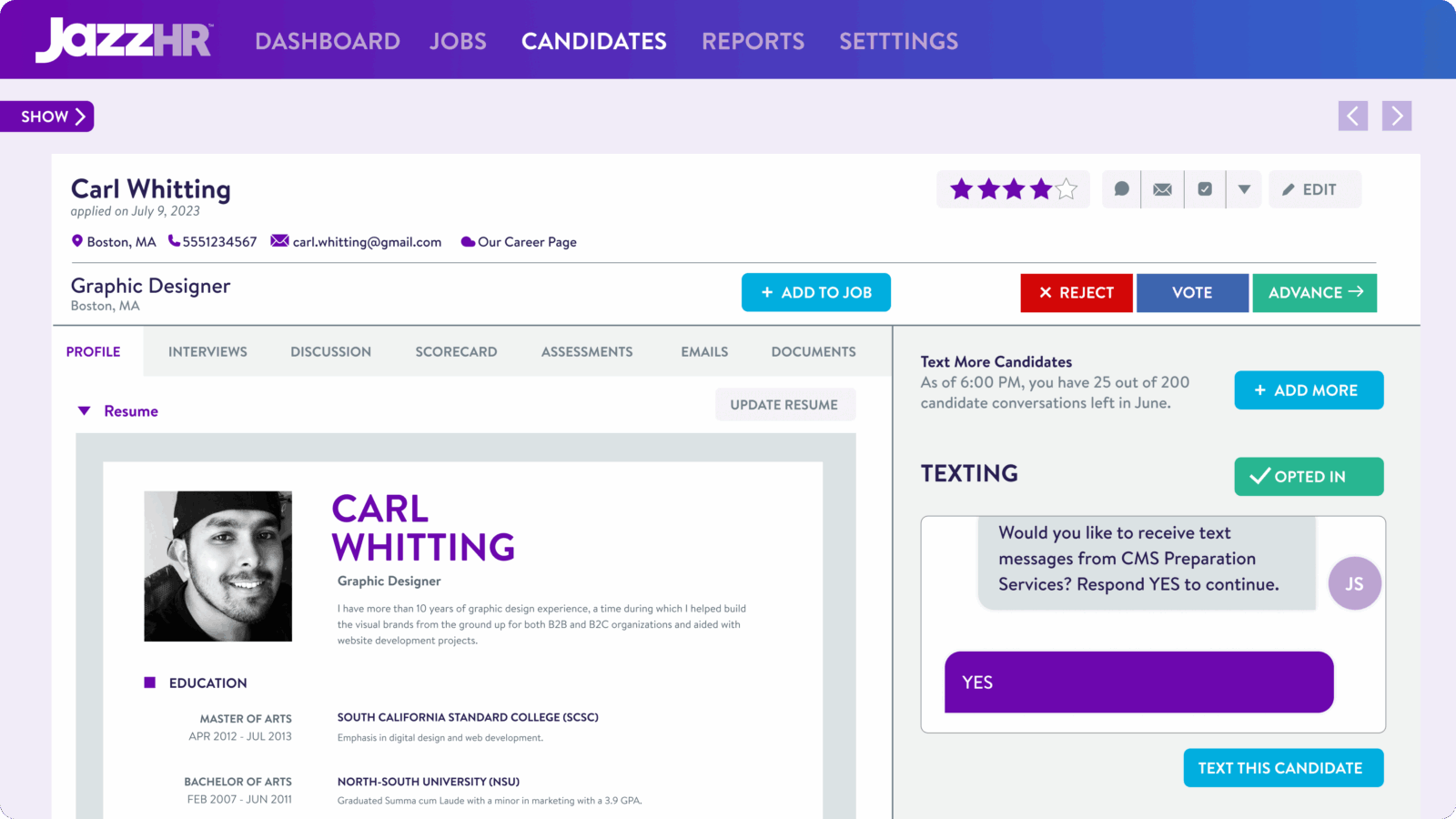The reasons to create an effective talent acquisition strategy are fairly obvious:
- Attracting and retaining top talent with the right skills, mindset, and company culture fit means your small business will perform at a high level and be appealing to job seekers.
- Engaging job seekers via savvy recruiting outreach and recruitment marketing and optimizing your outreach approach over time helps keep you candidate pool filled.
- Hiring managers can ensure critical roles on their teams are filled quickly and efficiently.
The key commonality among all successful talent acquisition strategies executed by HR teams today — including those at SMBs like yours — is the ability to balance achieving organizational goals tied to headcount growth company-wide and providing a consistently top-tier candidate experience.
5 reasons you need a strong talent acquisition strategy
You know the core tactics you need to carry out to for your talent acquisition strategy:
- Writing compelling impact job descriptions that detail not only the duties related to a given role, but also what’s expected of the chosen candidate
- Posting the latest openings to job boards, social media, and other popular and niche career communities to attract the right type(s) of talent
- Securing employee referrals from members of your workforce (from the C-level to entry-lever staff members) to bolster your candidate pool/database
- Proactively sourcing passive candidates by sending them personalized messages on LinkedIn and other proven to gauge their interest for roles
- Analyzing your recent and historical recruitment performance to identify “wins,” areas for improvement, and bottlenecks in your hiring process
- Ensuring your HR team engages candidates from different backgrounds and underrepresented groups to ensure you build a diverse workforce.
However, it’s worth taking a step back from your day-to-day recruitment efforts to learn the impact a methodical, systematic talent acquisition strategy that incorporates all of these activities (and many others) has on your hiring success.
With that in mind, here are five specific reasons you need to work with your C-suite and HR department to build and routinely refine your talent acquisition strategy.
1) A well-constructed talent acquisition strategy helps you stay competitive
The top competitors are — well — your top competitors because they have some of the best and brightest minds at their org. For you to be regarded as one of the best companies in your industry — and to compete fairly with the best — you need an effective talent acquisition strategy.
- Creating engagement with potential candidates you deem strong fits for open roles across your company will ensure that the time it takes to fill vacant positions is minimal.
The trick to doing this in a scalable manner, though, is to use an applicant tracking system (ATS) with built-in candidate relationship management capabilities — like nurture email and text messaging features.
“Investing in recruiting technology can have an incredible impact on recruiting by increasing the speed of the hiring process and helping recruiters improve the quality of candidates,” Employ SVP People & Talent recently shared with StrategicCHRO360.
And the ideal recruiting technology Corey refers to is a built-for-purpose ATS that:
- Offers rich insights into all talent in one’s database (applicants and passive prospects) that sheds light on how well the recruiting function performs in terms of increasing the application completion rate, reaching out to candidates, speeding up the interview process, and other facets of their recruitment efforts
- Shows where each of those individuals resides in their respective candidate pipeline (in other words, whether they’re a new “lead” that just applied for a job or an “advanced” prospect who’s nearing the end of a given hiring cycle)
- Informs recruiters as to how to best nurture and engage those folks and move the best ones into the interview stage so they can meet with hiring team members
- Enables HR teams to rediscover talent in their system to consider them for other roles that open up down the line (i.e., candidates with the ideal skills, experience, etc.)
“For those not using purpose-built technology, now could be the time, or you risk losing out on top-tier candidates,” Corey noted. Translation? Onboarding easy-to-use ATS software your entire hiring team can access and leverage in their day-today is your SMB’s path to a strong talent strategy.
One that simplifies and streamlines your daily recruiting tasks and leads to faster, smarter hires.
2) Your workforce determines your success — making attracting top talent vital
A key factor that determines success in any business is the people who make up the workforce. From the leadership, down to the technical and clerical levels, everyone is essential to business success.
And only the right individuals — that is, those with the requisite skills and expertise tied to a given role — will bring in the necessary skills, experience, and energy to ensure business success.
“Skills-based practices help companies find and attract a broader pool of talent filled with candidates who are better suited to fill these positions in the long term,” McKinsey partners recently wrote.
- Simply put, a highly effective and organized talent acquisition strategy enables you to identify folks who can interpret and run with the long-term visions and goals of your company.
So, what can you do to attract candidates who “fit the bill” for open positions at your org?
Mainly, by publishing richly detailed (yet fairly succinct) job postings to proven sourcing channels to get open roles (and your employer brand at large) in front of your ideal candidate persona (ICP).
As with other parts of your talent acquisition strategy, this will require some testing over time to see your desired results (i.e., a high quantity of high-quality professionals added to your talent pool).
But, take it from us: This ongoing experimentation is more than worth it, if it ultimately helps your SMB hire top-tier talent who can move the needle for your business and contribute to growth.
3) Coordinating your recruitment process helps future-proof your business
Talent acquisition is not just about hiring. (Though, that’s certainly the main goal.) It also involves ID’ing the right people for filling future positions by collecting the necessary data and keeping in touch.
Aside from the perk of having proactive minds that can steer your SMB away from challenges and unforeseen difficulties, you also have the advantage of filling crucial roles in a short time as needed.
- As seen in any good SMB’s business plan today, finding and hiring the right people is key to their company’s success in the short and long run.
To ensure you can boost your offer acceptance rate and onboard high-performing employees, close coordinated and collaboration between your hiring managers and recruiters is a must.
“Everyone wins when a recruiter and [a hiring manager] are on one team and have a common goal of finding the best candidate,” talent acquisition expert Iryna Gazhala recently wrote for RecruitingDaily.
The main aim of your HR team should not be to fill open positions with just anybody, but to have a well-structured plan that lets you recruit a suitable person while considering the long-term benefits that will guarantee growth and future success.
In other words?
You need to work with hiring managers to find and connect with top candidates who have a track record of considerable success in their respective line of work at previous employers and can clearly help your company in the same focus area.
- A bonus of hiring these individuals and empowering them to be successful in their role? An increase in employee retention, due to high job satisfaction.
Remember: Your talent acquisition strategy doesn’t solely entail finding and hiring top talent. You also must make sure any leads you speak with for openings want to stay at your business long term.
“Prioritize employee retention strategies to keep skilled and valuable employees engaged and happy,” Corey recently wrote for Forbes. Then, invest in current employees by creating an upskilling program.
4) Scalable, repeatable hiring processes reduce the odds of hiring failures
Talent acquisition is not work meant to be rushed. It entails a big-picture planning process built on the unique needs and wants of your small business. And for good reason.
- Those employees who “enter” your recruitment process are (ideally and only) qualified ones.
This reduces the risk of employing mediocre and unfit personnel. Whenever you need to lower a high employee turnover rate, you can trust an active talent acquisition strategy to come to the rescue.
Business expert Jeanne Hardy wrote for Forbes about how many small businesses hire on an “as-needed” basis today. Moving forward, though, she recommends SMBs think longer-term about their hiring approach.
“Today’s competitive job market, coupled with the wave of turnover expected from the ‘Great Resignation,’ requires that small businesses shift their approach to an ‘always hiring’ strategy,” said Jeanne.
You may never have high-volume hiring needs. But, building a well-oiled recruiting machine, so to speak, with the help of small business recruitment software (more on that shortly) can help you streamline all elements of your talent acquisition strategy and fill headcount more efficiently.
5) Having consistent TA processes and leading TA tech saves you money
One of the surest ways to boost productivity and ensure quality performance and results is by hiring a skilled and talented workforce. And the best way to identify a competent and proficient person is by adopting a good talent acquisition strategy
No doubt, this method saves costs in the long run.
Saving time and resources while maintaining high productivity is all every company desires. Executives must understand that it is their responsibility to reduce staffing costs, among other factors that constitute a higher risk for their companies.
- Technological evolution has forced most companies to restructure and modify their recruitment strategies to ensure that they stay relevant in their respective industries.
Despite the HR challenges faced by most companies that are trying to navigate the competitive employee landscape, the implementation of proper talent acquisition processes by small business leaders will all but guarantee an increase in their market share.
“Recruiters and HR decision-makers should prioritize the right mix of talent acquisition tools and hiring strategies to effectively and efficiently find and hire top talent,” said Employ CEO Pete Lamson.
Looking to take your talent acquisition strategy to new heights? Find out how thousands of SMBs use JazzHR to elevate their hiring performance — and how our ATS can help your company do the same.


